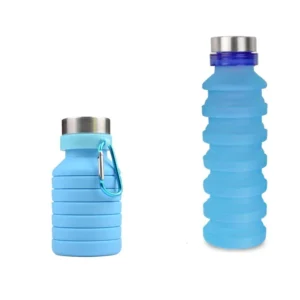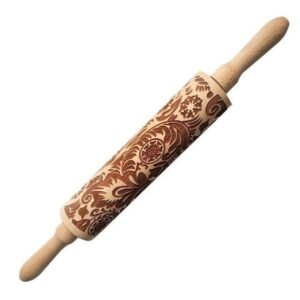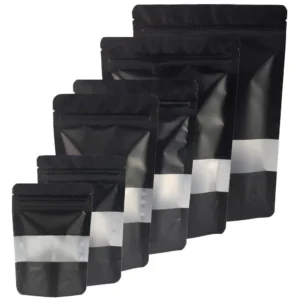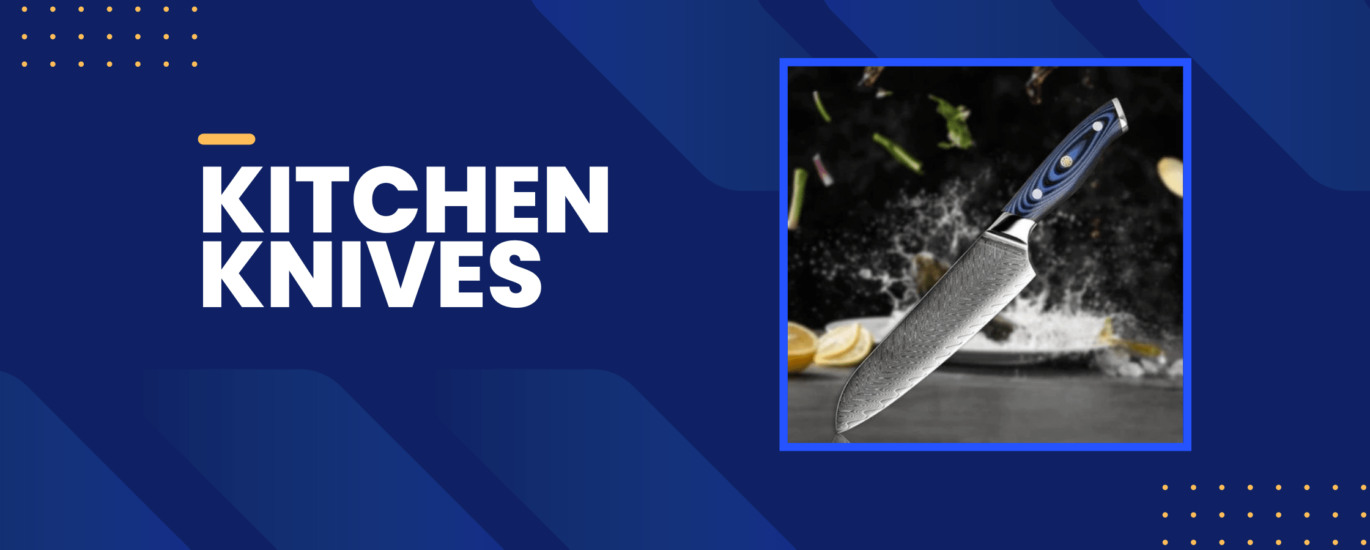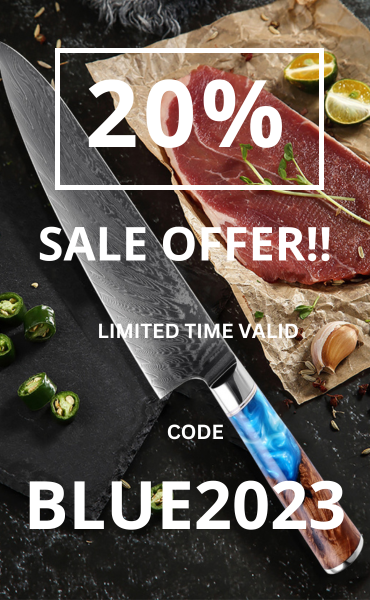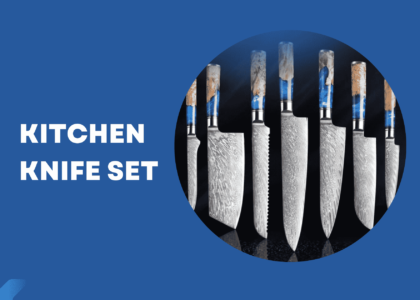Introduction
Kitchen Knives: A Culinary Essential
A kitchen knife is more than a tool; it’s an extension of a chef’s hand. The right knife not only aids in preparing dishes but also enhances the culinary experience, ensuring precision and consistency in every cut. From dicing vegetables to carving meats, kitchen knives play a pivotal role in diverse cooking techniques.

Understanding the Importance of a Good Knife
A good knife is paramount in the culinary world. It ensures:
- Precision: Accurate cuts and slices.
- Efficiency: Speeds up the food preparation process.
- Safety: A sharp, well-maintained knife is safer as it requires less force and provides better control. Importance Description Precision in cuts Ensures uniformity in food preparation Enhanced efficiency Reduces preparation time Safety Minimizes risk of accidents
The Anatomy of a Kitchen Knife
Understanding a kitchen knife involves recognizing its various parts:
- Blade: The cutting surface, which can be made from various materials like stainless steel or carbon steel.
- Handle: Where the user grips the knife. It can be made from wood, plastic, or metal.
- Edge: The sharpened side of the blade.
- Spine: The unsharpened side of the blade.
- Tang: The part of the blade that extends into the handle, providing balance.
- Bolster: The thick junction between the handle and blade, ensuring stability and safety. Part Function Blade Performs the cutting and chopping Handle Ensures grip and control during use Edge The sharp side used for cutting Spine Provides stability and weight to the knife Tang Balances the knife and ensures durability Bolster Acts as a safety barrier and adds stability
Exploring Types of Kitchen Knives
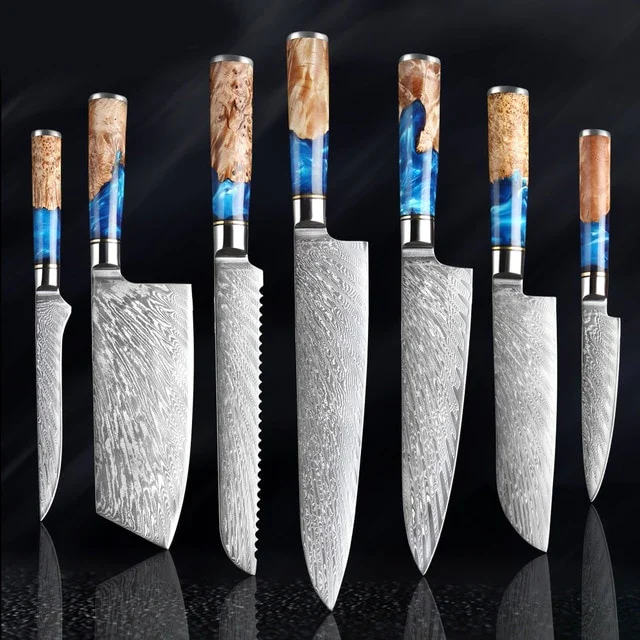
Chef’s Knife: The Kitchen Workhorse
The Chef’s Knife is often deemed the quintessential tool in the kitchen, renowned for its versatility. It excels in various tasks, from mincing onions to chopping herbs, making it an indispensable asset for chefs and home cooks alike.
| Key Use | Description |
|---|---|
| Chopping | Efficiently chops vegetables, fruits, and herbs |
| Mincing | Easily minces garlic, onions, and herbs |
| Slicing | Slices through meats and vegetables with precision |
Paring Knife: The Detail Expert
A Paring Knife is celebrated for its precision in handling intricate tasks like peeling, deseeding, and other detailed cutting, where larger knives may be cumbersome. Its petite size and sharp blade make it ideal for finesse and control.
| Key Use | Description |
|---|---|
| Peeling | Perfect for peeling fruits and vegetables |
| Deseeding | Easily removes seeds from fruits and vegetables |
| Detail Cutting | Ideal for intricate cuts and carvings |
Bread Knife: Slicing with Ease
With a serrated edge, the Bread Knife is crafted to slice through bread without crushing it, ensuring clean and even slices. It can also be utilized for slicing through soft fruits like tomatoes without squashing them.
| Key Use | Description |
|---|---|
| Bread Slicing | Achieves clean slices of bread without crushing |
| Soft Fruits | Slices through soft-skinned fruits without squashing |
Santoku Knife: The Japanese Marvel
The Santoku Knife is recognized for its three virtues: chopping, slicing, and dicing. Originating from Japan, it is characterized by its shorter blade and balanced handling, making it a favorite among chefs for various cutting tasks.
| Key Use | Description |
|---|---|
| Chopping | Efficient in chopping a variety of ingredients |
| Slicing | Slices through fish, meat, and vegetables |
| Dicing | Achieves uniform dices of vegetables and meats |
Boning Knife: Deboning and Filleting
The Boning Knife, with its slender blade and pointed tip, is designed to debone meats and fillet fish with precision, ensuring minimal wastage and clean cuts.
| Key Use | Description |
|---|---|
| Deboning | Efficiently removes bones from meat |
| Filleting | Achieves clean fillets of fish |
Cleaver: Chopping with Precision
The Cleaver, with its broad and heavy blade, is the powerhouse among kitchen knives. It effortlessly chops through bones and hard vegetables, making it a staple in meat preparation.
| Key Use | Description |
|---|---|
| Chopping Bones | Easily chops through bones and cartilage |
| Hard Vegetables | Cuts through hard vegetables like squash and pumpkin |
Nakiri: Vegetable Cutting Excellence
The Nakiri, with its thin, double-beveled blade, is tailored for chopping vegetables. It ensures clean, swift cuts without damaging delicate vegetables, making it a vegetable chef’s favorite.
| Key Use | Description |
|---|---|
| Vegetable Chopping | Achieves clean and even chops of vegetables |
| Thin Slicing | Slices through delicate vegetables without damage |
Exploring Noteworthy Kitchen Knives and Brands
A Glimpse into Renowned Kitchen Knife Brands
When exploring kitchen knives, certain brands like Henckels, Wusthof, and Morphy Richards often stand out due to their distinct features and customer loyalty. Each brand brings something unique to the table, and it’s crucial to research and consider personal preferences regarding design and blade material when choosing a knife.
Chef’s Knife: A Quintessential Tool in Every Kitchen
The chef’s knife, notably the Damascus Chef Knife, is renowned for its versatility in cutting meat and chopping vegetables, thanks to its wide, approximately 7-inch long blade. Its curved, double-sided sharpened blade ensures even chopping, while the serrated edge assists in cutting through tough foods. Made from high-quality materials like stainless steel, chef’s knives are lightweight, easy to handle, and pivotal for precision in cooking.
Meat Cleaver: A Sturdy Companion for Heavy-Duty Tasks
The Meat Cleaver is another vital kitchen knife, especially for those who frequently deal with meats. With a flat, robust blade, it effortlessly cuts through meat, providing a smooth and easy chopping experience.
Knife Sets: A Comprehensive Solution
For those who seek variety and completeness, Damascus Kitchen Knife sets offer a range of kitchen knives to cater to different culinary needs, ensuring you have the right tool for every task. From a chef’s knife for versatile cutting to a paring knife for smaller, detailed tasks, a good knife set provides a comprehensive solution for culinary enthusiasts.
Professional Serbian Boning Knife: A Precision Tool for Delicate Cuts
The Professional Serbian Boning Knife is a noteworthy mention for those who require a knife specifically designed for boning and cutting through fish and other delicate items. Its thin, sharp blade ensures precision without damaging the food.
Sushi Knives: Mastering the Art of Delicate Slicing
For sushi enthusiasts and chefs, a sushi knife, known for its thin and extremely sharp blade, is indispensable. It allows the chef to set the stage for meticulous and delicate slicing of fish and other ingredients without compromising their integrity.
Knife Selection Guide
Factors to Consider: Material, Weight, Balance, and Handle
Selecting the right kitchen knife involves considering various factors to ensure it meets your culinary needs and provides a comfortable user experience.
- Material: Choose between stainless steel, carbon steel, or ceramic, each offering different levels of durability and maintenance.
- Weight: Opt for a weight that feels balanced and comfortable in your hand.
- Balance: Ensure the knife feels stable, with even weight distribution between the handle and blade.
- Handle: Select a handle material and design that provides a secure grip.
| Factor | Importance |
|---|---|
| Material | Determines durability and maintenance |
| Weight | Influences ease of use and comfort |
| Balance | Affects stability and control during use |
| Handle | Impacts grip and safety |
Price vs. Quality: Making a Wise Investment
Investing in a kitchen knife involves balancing price and quality. While it might be tempting to opt for budget-friendly options, investing in a high-quality knife can offer long-term benefits, including:
- Durability: Higher quality knives often boast superior durability, retaining their sharpness and functionality over time.
- Performance: A well-crafted knife ensures optimal performance, providing clean and precise cuts.
- Safety: Quality knives tend to offer better stability and sharpness, reducing the risk of accidents.
| Consideration | Description |
|---|---|
| Durability | Ensures the knife retains its quality over time |
| Performance | Influences the precision and cleanliness of cuts |
| Safety | Reduces the risk of accidents during use |
what to look for when buying kitchen knives?
When buying kitchen knives, there are several important factors to consider.
- First and foremost, it is crucial to look for knives that are made of high-quality materials. Stainless steel is a popular choice as it is durable and resistant to corrosion.
- Additionally, consider the type of knife you need. Different knives are designed for specific tasks, such as slicing, chopping, or paring.
- It is also important to consider the handle of the knife. Look for a knife with a comfortable and ergonomic handle that provides a secure grip.
- Another important factor to consider is the blade sharpness. A sharp blade will make your cutting tasks easier and more efficient.
- Finally, consider the overall balance and weight of the knife. A well-balanced knife will feel comfortable in your hand and make cutting tasks more precise. By considering these factors, you can ensure that you are purchasing kitchen knives that meet your needs and will last for years to come.
What to consider when shopping for a chef’s knife?
When shopping for the best chef’s knife, it’s ideal to hold the ones you’re considering so you can get a feel for them. At the end of the day, your go-to knife is largely based on personal preference. What might feel perfectly balanced to one cook may feel heavy to another. Here’s what to consider:
Type: German or Western knives are great for heavy-duty tasks like chopping and breaking down a chicken, while Japanese knives are well suited to more delicate and precise tasks like cleanly slicing cucumbers. Because Japanese knives are crafted from harder steel, they can typically last longer between sharpening sessions, but they may be prone to chipping or cracking. The softer steel in Western knives might not hold an edge as long, but they tend to be sturdy.
Handle: Handles are generally made of wood or wood composites, plastic or metal. The type of material affects the weight and feel of the knife, as well as the price. Choose the knife you’ll reach for again and again. But take note that wood might warp or splinter over time due to use and washing.
Tang: Our pros recommend knives that have a full tang, which means the blade runs through the handle, rather than just being inserted into it. A full tang keeps the blade more secure over the life of the knife and helps the knife feel balanced for better control.
Bolster: The bolster, or how and where the blade flows into the handle, is another point of differentiation. Some are full bolsters, meaning they cover the whole back end of the blade, while some are semi-bolsters that cover only a portion of the blade. We found that a full bolster allows for a more protected grip for novices, while a semi-bolster (or no bolster) provides a more controlled grip for chefs who like to pinch the heel of the blade. In addition, this section of the knife can be angled or straight, and you may have to try a few styles to find what you prefer.
Bottom line: Look for a knife that feels like an extension of your hand, and keep it sharp. A sharp knife requires less effort and pressure on your part, which makes slicing safer easier, more stable and less tiring.
Knife Maintenance and Safety
Sharpening Techniques and Tools
Maintaining the sharpness of your kitchen knives is pivotal for optimal performance and safety. Employ sharpening stones or honing rods to preserve the edge of the blade. Utilize the following techniques:
- Whetstone Sharpening: Soak the stone, and glide the knife across it at a 20-degree angle.
- Honing: Use a rod to realign the blade’s edge, maintaining its sharpness between sharpenings.
| Technique | Tool | Purpose |
|---|---|---|
| Whetstone Sharpening | Sharpening Stone | Grinds and hones the blade |
| Honing | Honing Rod | Realignment of the blade’s edge |
Safe Storage Solutions
Safe storage of kitchen knives is crucial to prevent accidents and preserve their condition. Consider:
- Magnetic Strips: Securely hold knives and provide easy access.
- Knife Blocks: Protect the blades and offer organized storage.
- Drawer Inserts: Keep knives separated and protected in a drawer.
| Storage Solution | Benefit |
|---|---|
| Magnetic Strips | Easy access and visibility |
| Knife Blocks | Organized and protective storage |
| Drawer Inserts | Concealed and separated storage |
Handling and Usage Safety Tips
Ensuring safety while using kitchen knives involves mindful practices and adherence to guidelines:
- Proper Grip: Hold the knife securely, with fingers away from the blade.
- Cutting Surface: Use a stable and slip-resistant cutting board.
- Knife Cleaning: Always wash knives separately, not in a filled sink, to prevent accidental cuts.
| Safety Tip | Importance |
|---|---|
| Proper Grip | Prevents slipping and ensures control |
| Cutting Surface | Provides stability during chopping |
| Knife Cleaning | Avoids accidental injuries during washing |
How to Keep Kitchen Knives Sharp?
To keep your kitchen knives sharp, it is important to follow a few key steps.
- First, make sure to regularly hone your knives using a honing rod. This will help to realign the edge of the blade and keep it sharp. Additionally, it is important to store your knives properly to prevent them from becoming dull.
- Consider using a knife block or a magnetic strip to keep them safely stored and protected. Avoid placing knives in a drawer where they can rub against other utensils and lose their sharpness.
- Another important tip is to always use a cutting board made of wood or plastic, as using hard surfaces like glass or granite can quickly dull your knives.
- Finally, be sure to hand wash your knives rather than putting them in the dishwasher. The harsh detergents and high heat can damage the blades and make them less effective. By following these tips, you can ensure that your kitchen knives stay sharp and ready for use.
How to Remove Rust Spots from Kitchen Knives?
To remove rust spots from kitchen knives, you can follow these simple steps:
- Prepare a solution of equal parts white vinegar and water. You can also use lemon juice or baking soda mixed with water as an alternative.
- Submerge the rusty knife blade in the solution and let it soak for about 5-10 minutes. This will help to loosen the rust.
- Use a soft-bristled toothbrush or a sponge to gently scrub the rust spots. Be careful not to apply too much pressure, as this can damage the knife blade.
- Rinse the knife blade thoroughly with water to remove any residue from the cleaning solution.
- Dry the knife blade completely using a clean towel to prevent any further rusting.
- Apply a thin layer of food-grade mineral oil or vegetable oil to the knife blade to protect it from future rusting. This will create a barrier against moisture.
By following these steps, you can effectively remove rust spots from your kitchen knives and keep them in good condition for longer. Remember to always handle knives with care and store them in a dry place to prevent rusting.
Culinary Techniques with Kitchen Knives
Basic Knife Skills: Chopping, Dicing, and Mincing
Mastering basic knife skills is fundamental to efficient cooking and presenting aesthetically pleasing dishes.
- Chopping: Use a rocking motion with the kitchen knife, keeping the tip on the cutting board.
- Dicing: Create uniform cubes by making even, parallel cuts.
- Mincing: Use rapid, rocking cuts to finely chop ingredients, such as garlic or herbs.
| Skill | Description |
|---|---|
| Chopping | Roughly cutting ingredients into pieces |
| Dicing | Cutting ingredients into uniform cubes |
| Mincing | Finely chopping ingredients into tiny pieces |
Advanced Techniques: Julienne and Chiffonade
Advanced knife techniques elevate the visual appeal and texture of dishes.
- Julienne: Cut ingredients into thin, uniform strips, often used for stir-fries or garnishes.
- Chiffonade: Roll leafy vegetables or herbs and slice them thinly to create ribbon-like strands, enhancing salads or soups.
| Technique | Description | Application |
|---|---|---|
| Julienne | Cutting into thin, uniform strips | Stir-fries, garnishes |
| Chiffonade | Slicing into thin ribbons | Salads, soups |
Butchering and Filleting Techniques
Efficient butchering and filleting require specific kitchen knife skills to ensure minimal wastage and preserve the integrity of the meat.
- Butchering: Disassemble a piece of meat into smaller portions, utilizing various cuts.
- Filleting: Remove the bones from fish or meat, leaving behind a clean, boneless piece ready for cooking.
| Technique | Description | Application |
|---|---|---|
| Butchering | Cutting meat into smaller portions | Steaks, chops |
| Filleting | Removing bones from meat or fish | Boneless meat or fish fillets |
Conclusion
In the journey through the world of kitchen knives, we’ve sliced through various topics, from understanding their anatomy, exploring diverse types, mastering selection criteria, to honing culinary techniques. The essence of a kitchen knife transcends its physical form, becoming a vital extension of the culinary artist’s hand, guiding each cut, chop, and slice towards culinary excellence. As you embark on your culinary adventures, let the knowledge of knives be your guide, ensuring precision, safety, and artistry in every dish you craft. May your knives remain sharp, and your cooking experiences be ever delightful and flavorful.
FAQs
How to Choose the Right Knife for Cooking Task?
Selecting the right kitchen knife involves considering the task, ensuring the blade type and size are suitable for the ingredients and cutting style.
How Often Should Kitchen Knives be Sharpened?
Kitchen knives should be sharpened every few months, depending on usage, to maintain optimal performance and safety during culinary tasks.
What is the Difference Between Western and Japanese Knives?
Western knives typically have a heavier, more robust build with a curved blade, while Japanese knives often feature a lighter, straighter blade, emphasizing precision and finesse.
Which is the Best Knife for Kitchen?
The best kitchen knife varies per individual and task but often, a quality chef’s knife is considered versatile and essential in most culinary settings.
What are the Only 3 Kitchen Knives You Need?
Essentially, a chef’s knife for versatile cutting, a paring knife for detailed tasks, and a bread knife for slicing are often deemed the three key kitchen knives.
What is Kitchen Knife Used For?
A kitchen knife is used for various culinary preparation tasks, including chopping, slicing, dicing, and mincing ingredients, ensuring precision and efficiency in cooking.
Frequently Linked Pages
1. Kitchen Knife Set – Unlocking the Secrets of the Ideal Kitchen Knife Set: A Comprehensive Guide
2. Damascus Knifes – Damascus Knifes: A Symphony of Craftsmanship and Functionality
3. Knife Damascus – Unveiling the Craftsmanship of Knife Damascus: A Comprehensive Guide
4. Knives Damascus – Mastering the Art of Culinary with Knives Damascus: A Comprehensive Guide


